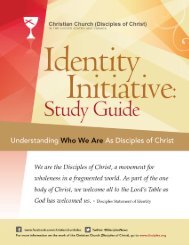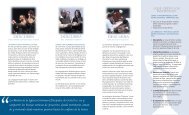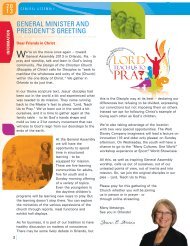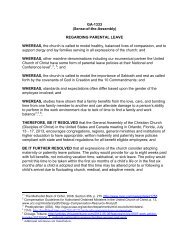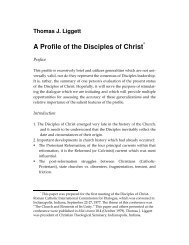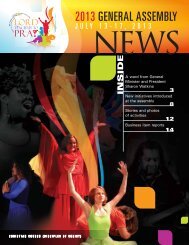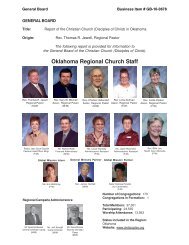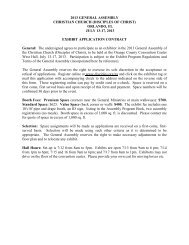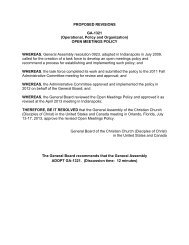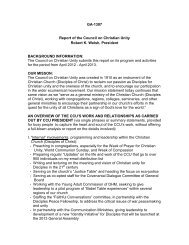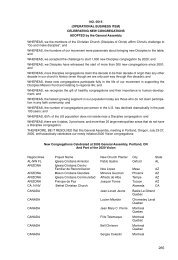RESOURCING THE CHURCH FOR ECUMENICAL MINISTRy A ...
RESOURCING THE CHURCH FOR ECUMENICAL MINISTRy A ...
RESOURCING THE CHURCH FOR ECUMENICAL MINISTRy A ...
You also want an ePaper? Increase the reach of your titles
YUMPU automatically turns print PDFs into web optimized ePapers that Google loves.
that is like a Bach fugue—lifting, floating, flying! For<br />
the first fourteen years of our life as a Council, Peter<br />
Ainslie, pastor of Christian Temple of Baltimore,<br />
served as president.<br />
Dark days came to the Council in the 1920s. The<br />
Disciples were in the often angry agony of dividing.<br />
Peter Ainslie was in the spotlight of contention. He<br />
felt he had to remove himself as president of the<br />
Council. The days were so dark that Professor<br />
Willett of Chicago voiced the fear in many people’s<br />
hearts: Can the Council survive without Ainslie?<br />
More than a church fight, it was the very wounding<br />
of the body of Christ. The music in the heart of<br />
those who loved God’s one church was Bach’s “O<br />
Sacred Head now wounded, with grief and shame<br />
weighed down; . . . mine, mine, was the transgression,<br />
but thine the deadly<br />
pain.”<br />
A dozen years earlier Peter<br />
Ainslie had been a mentor to<br />
a young student he met in<br />
New Haven when he was there<br />
to give the Yale Lectures.<br />
Soon H.C. Armstrong was<br />
on the staff of Christian<br />
Temple with his portfolio primarily focused on the<br />
work of the Council. God had given us a prophet in<br />
Ainslie. Now God gave us a healer. H.C. Armstrong<br />
led the Council from 1925 to 1931. We can thank<br />
God for H.C. Armstrong that we are still here.<br />
George Walker Buckner was one of the volunteer<br />
leaders who guided us through the lean depression<br />
years of the 1930s. When the financial recovery<br />
began, he was named the executive director on a<br />
halftime basis, along with serving as editor of World<br />
Call magazine. Through him we Disciples were<br />
present and contributing when the provisional<br />
committee was forming the World Council of<br />
Churches and when plans were drafted for the<br />
National Council of Churches. The love and<br />
commitment of George Buckner to our Council’s<br />
calling was like a Bach toccata. It was the music for<br />
us to anticipate and prepare for the fugue that<br />
followed it and sent us soaring again.<br />
Soar we did. George Beazley came to the presidency<br />
like Bach’s great Fugue in D Minor. In 1961, after the<br />
controversies and the lean times we again were lifted<br />
and floating and flying! George Beazley gave us the<br />
gift of contagious enthusiasm. His ministry is<br />
remembered for the “Beazley Buzz” and Midstream<br />
Morgan • Celebrating 100 Years as a Movement for Unity<br />
The celebration is not primarily<br />
your celebration. It is the church<br />
celebrating once again God<br />
trusting it to propagate the gospel.”<br />
2<br />
journal and his pioneer work of bringing Disciples<br />
on board with the Consultation on Church Union.<br />
Dr. Beazley died on World Communion Sunday—<br />
during an ecumenical trip to the Soviet Union.<br />
In God’s providence the great soaring fugue continued.<br />
However, with Paul Crow you get more than<br />
a fugue: you get the whole Bach repertoire. Our<br />
longest serving president brought us to prominence<br />
in the worldwide ecumenical movement of the late<br />
twentieth century. A colleague once shared with me<br />
of being in the Soviet Union for the millennial<br />
celebration of the Christian witness of the Russian<br />
people. An orthodox priest made a friendly inquiry<br />
about her church in the United States. She said, “Oh,<br />
you wouldn’t know us. I’m a Disciples of Christ.” He<br />
replied, “Oh, yes, I know you. I know Paul Crow.”<br />
I recently led a retreat of<br />
Roman Catholics and Disciples<br />
in West Virginia. One of<br />
the first priests I met asked,<br />
“Do you know my friend Paul<br />
Crow?” Far away Russia,<br />
remote West Virginia—the<br />
Disciples ecumenical witness is<br />
known.<br />
Let me recite a very abbreviated list of the Council’s<br />
accomplishments with Paul’s leadership: International<br />
Commission for Dialogue between<br />
Disciples of Christ and the Roman Catholic Church,<br />
full ecumenical partnership of the Disciples and the<br />
United Church of Christ, the creation of the Peter<br />
Ainslie III Lectures, and the Joe and Nancy Vaughn<br />
Stalcup Lectures on Christian Unity, and the work of<br />
the Disciples Commission on Theology which led to<br />
the publication of the major volume, The Church for<br />
Disciples of Christ.<br />
For this last decade we have been led by Robert<br />
Welsh. Robert’s leadership has connections to the<br />
legacy of Peter Ainslie. Ainslie called Disciples again<br />
to our founder’s frontier vision to be a people of<br />
unity. Ainslie mentored H. C. Armstrong so that a<br />
new generation could ably take its place in ecumenical<br />
leadership. Robert and the Council are<br />
calling us again to form a new generation of leaders<br />
as we go to new frontiers of exploring interfaith<br />
dialogue and healing the wounds among those who<br />
share the legacy of Barton Stone and Thomas and<br />
Alexander Campbell.<br />
Robert and Peter share another gift, the solid




